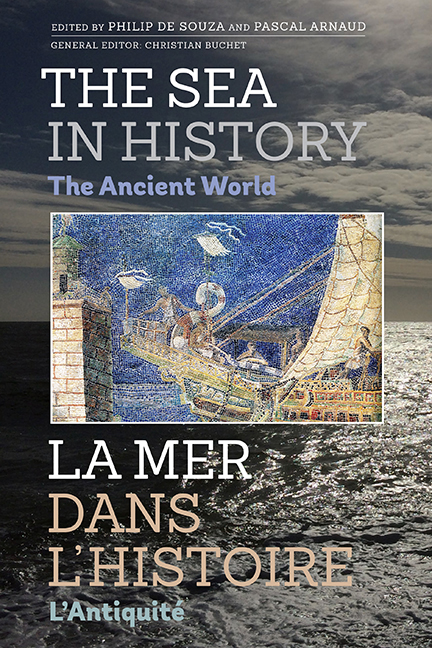Book contents
- Frontmatter
- Contents
- List of Illustrations
- List of Contributors
- Introduction générale et remerciements par Christian Buchet
- General introduction and acknowledgements
- Introduction (français)
- Introduction (English)
- La mer est le propre d'Homo sapiens
- PREHISTORICAL CASE STUDIES
- HISTORIAL CASE STUDIES: The Ancient Near East and Pharaonic Egypt
- HISTORICAL CASE STUDIES: The Mediterranean world
- HISTORICAL CASE STUDIES: The Indian Ocean and the Far East
- L'océan Indien dans l'Antiquité: science, commerce et géopolitique
- Ancient seafaring in Eastern African Indian Ocean waters
- Early China and the Indian Ocean networks
- The mobility of people and ideas on the seas of Ancient India
- Ships, Sailors and Kingdoms of Ancient Southeast Asia
- La violence maritime comme reflet du contexte géopolitique: une piraterie sui generis dans l'Asie du Sud-est des premières cités-entrepôts indianisées
- Conclusion (français)
- Conclusion (English)
- Conclusion générale par Christian Buchet
- General conclusion
- Comprendre le rôle de la mer dans L'histoire pour éclairer notre avenir
- Understanding the role the sea has played in our past in order to shed light on our future!
Ships, Sailors and Kingdoms of Ancient Southeast Asia
from HISTORICAL CASE STUDIES: The Indian Ocean and the Far East
Published online by Cambridge University Press: 20 April 2017
- Frontmatter
- Contents
- List of Illustrations
- List of Contributors
- Introduction générale et remerciements par Christian Buchet
- General introduction and acknowledgements
- Introduction (français)
- Introduction (English)
- La mer est le propre d'Homo sapiens
- PREHISTORICAL CASE STUDIES
- HISTORIAL CASE STUDIES: The Ancient Near East and Pharaonic Egypt
- HISTORICAL CASE STUDIES: The Mediterranean world
- HISTORICAL CASE STUDIES: The Indian Ocean and the Far East
- L'océan Indien dans l'Antiquité: science, commerce et géopolitique
- Ancient seafaring in Eastern African Indian Ocean waters
- Early China and the Indian Ocean networks
- The mobility of people and ideas on the seas of Ancient India
- Ships, Sailors and Kingdoms of Ancient Southeast Asia
- La violence maritime comme reflet du contexte géopolitique: une piraterie sui generis dans l'Asie du Sud-est des premières cités-entrepôts indianisées
- Conclusion (français)
- Conclusion (English)
- Conclusion générale par Christian Buchet
- General conclusion
- Comprendre le rôle de la mer dans L'histoire pour éclairer notre avenir
- Understanding the role the sea has played in our past in order to shed light on our future!
Summary
ABSTRACT.This contribution explores the maritime history of Southeast Asian seafaring populations from 500 BC to AD 1500. The initial focus is on seafaring technology and trade, followed by social and political aspects, discussing how these maritime cultures became wealthy through their control of the sea lanes between China and the Indian Ocean, and how they successfully resisted attempts by agrarian empires to tame them, until the arrival of the Dutch and the English during the 17th century AD.
RÉSUMÉ.Cette contribution explore L'histoire maritime des peuples marins d'Asie du Sud-est de 500 av. J.-C. à 1500 ap. J.-C. En s'intéressant d'abord au commerce et à la technologie maritimes puis aux aspects politiques et sociaux de la question, elle analyse comment ces cultures s'enrichirent grâce à leur contrôle des voies maritimes entre la Chine et l'océan Indien, et résistèrent aux tentatives de soumission menées par des empires agricoles jusqu'à l'arrivée des néerlandais et des britanniques au XVIIe siècle.
WINDS AND ROUTES
The Pearl Road was divided into two main sectors: lands ‘above the wind’ (the Indian Ocean), and lands ‘below the wind’, Zirbâdât in Arabic (the Straits of Malacca, South China Sea, Java Sea, and further east). These terms refer to seasons for sailing in relation to the monsoon winds. Long-distance voyaging along these routes became possible once seafarers discovered the principle of seasonal winds which provide reliable power for sailing ships. This information was probably known to ancient Arabo-Persian and Malay sailors; the Graeco-Romans acquired it around the first century AD.
It was almost impossible to sail from the lands above the wind to the lands below the wind in one monsoon. By the time ships from the west arrived in the Straits of Malacca, the western monsoon was dying. Voyagers either had to remain in the Straits for six months until the west wind returned before proceeding further east, or quickly stock up on Chinese and Southeast Asian commodities stored in the Straits and return home.
- Type
- Chapter
- Information
- The Sea in History - The Ancient World , pp. 560 - 572Publisher: Boydell & BrewerPrint publication year: 2017
- 2
- Cited by

